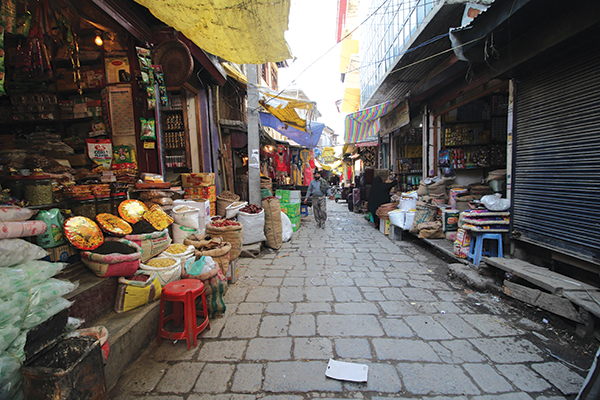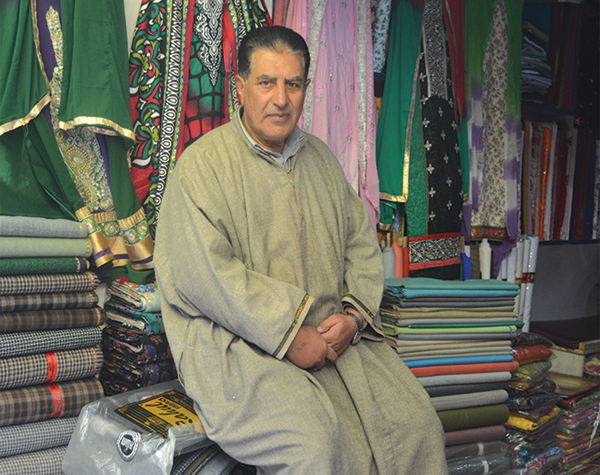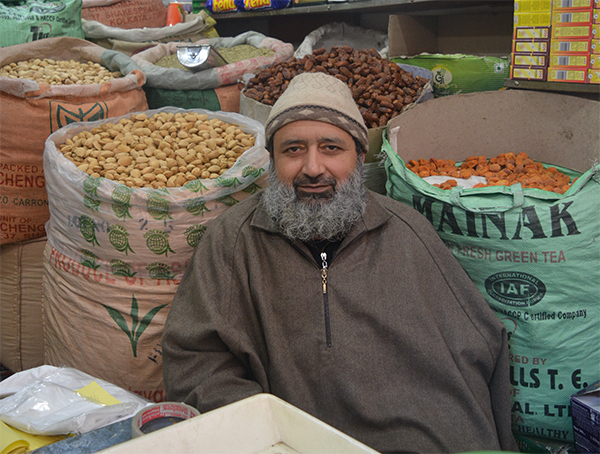Zainakadal in Srinagar’s downtown has witnessed and withstood brutalities, massacres, regime changes, kings and occupiers, without losing its essence. But that was before the dawn of 90s. Shakir Mir revisits Gaade Koche massacre that shook the area like never before

Behind the bustling streets of Bohri Kadal in Old city lies a labyrinth of corridors meandering amorphously like the cracks in a jigsaw puzzle.
Placed right next to banks of River Jhelum, the alleys of Gaade Koch – translated loosely as Fish Lane – cut through old traditional buildings; some of which have become darkened with the passage of time. The walls of these building are smeared with marks, and defacements, bearing testimony to the darkest phase of Kashmir’s blood-soaked history.
Although there are many old markets found within the interiors of the Srinagar city but Gaade Koch captures attention like none other, particularly in wake of its idiosyncratic life and composition.
There are some major cosmetic wholesale dealers in the lane whose items, some store-owners claim, makeup almost eighty per cent of stock available with the retailers across the Srinagar city.
The thin lanes of Gaade Koch are made up of Devri curbstones interred into streets in a chessboard fashion. Walls of old structures look shabby due to the presence of large scabs of worn-off earthen plaster. Aromatic fumes wafts across its compact lanes where many store-owners have decorated bagful of spices and forest-derived herbs including the iconic Hand, Wopal Haak, Turmeric Rhizomes, Abuj leaves and much more.
The lanes of Gaade Koch encompass over three-hundred stores with the majority of them dealing in dry fruits, rustic herbs, textiles, cosmetics and copperware. “Only monthly turnover of a handful of big stores exceeds crores,” says Sajad, a former resident of Bohri Kadal who shifted from the locality during late 90’s when insurgents, taking advantage of the maze-like lanes, mounted audacious hit-and-run attacks on military bunkers.
It was precisely because of this reason that many residents abandoned their homes and fled. “The bunkers were erected practically at every corner and as a result shopkeepers became very vulnerable to the prospective assaults.”
Today, the lanes of Gaade Koche are bustling with business activity till 10 PM, but the remnants of a massacre are still visible.
On a soggy afternoon of 10 February in 1995, here in these lanes, 16-year-old Salim Hamid returned from the mosque near Bohri Kadal after offering Asar prayers. It was co-incidentally the 10th day of Ramadan as well. In the prime of his adolescence, Salim, an 11th class student, was incredulous about holding fast. He routinely nagged his father into buying him sweets before Iftaar drew closer by evening.
“He came up to my shop that day,” recalls Abdul Hamid, Salim’s father and a textile merchant in Gaade Koch. “I told him to buy sooji (Semolina) so that he could prepare a pudding for himself.”
Just a few yards away, a camp of Border Security Force (BSF) – 1Bn – was stationed in the building. During the early 90s, when Indian forces were despised for having involved in numerous killings across Kashmir, in Gaade Koch they had rather an extraordinary record of co-existing with the businessmen, often soliciting favour or two from each other.
“They would come and purchase ration and other household items on credit and then pay whenever they would want,” recollects, Ashfaq, a copperware dealer. “It never bothered us as long as they paid eventually. We had built a cordial relationship.”

At around 4 PM, the business was going as usual: Store-owners were unmindful to the spectacle that was to unfold. Buyers haggled tirelessly with the salesmen in anticipation they would lower down the price. Cycles trilled aside the crowed, navigating gingerly to whizz past them.
Salim turned up at a dry fruit store to purchase ingredients for the pudding. The owner, Ghulam Nabi, 65, was courteous, cupping the boy’s face with hands in adoration. Suddenly, two deafening thuds rang aloud.
People on the streets cowered down with panic in a unison. Many of them ran across the road, looking for cover. About a dozen squeezed into the mosque.
Salim’s father grew frightened. Just when he strode a step ahead to look out what had happened, sounds of gunfire broke out in staccato. Clouds of smoke engulfed the surroundings, obscuring practically everything.
Militants of Harkat-ul-Ansar had stormed a BSF bunker stationed nearby, allegedly decamping with their service rifles and fleeing gracefully before the forces could have retaliated.
In the ensuing chaos, a feran-clad young combatant on the street took out his automatic weapon and fired with precision at a BSF man. The solider, Manzoor Ahmad, let out a shriek, wincing at the agonizing bullet injury. Ahmad staggered for a moment, reciting aloud the verses from Quran before falling down.
Enraged, the BSF unleashed a torrent of violence on the streets, firing indiscriminately and bumping off whomever they could lay their hands on, irrespective of their involvement with the “crime”. In the retaliation, it later turned out, some seven people, all of them civilians, had died.
“The BSF personnel,” a Daily Kashmir Times report quoting victims wrote, “collected inmates of these houses in different rooms and tortured them.”
It revealed that the ladies of these houses were allegedly beaten and their heads immersed in a bucket of water to make them cough out “details” about the assailants.
“The firing was so intense and so prolonged that one could not dare to see across to the neighboring store,” Hamid recalls, expecting that his son too would have hid himself away safely.
The firing lasted for four hours. Hamid and the other store keepers had been lodged in one corner of the room, shuddering with fear, not knowing which minute would be their last.
Just few meters away, Zahoor Ahmad Dhar, a wholesale dealer of cosmetics, hid underneath the store counter, crouching against the barrage of bullets many of which hit his shutter.
“It happened all of the sudden,” he says. “I did not know how to react. I just wanted to save myself.”
Amid unrestrained firing, a posse of BSF men stormed into his store. “Come out,” they said, sternly.
One of the men caught Dhar by his scruff and dragged him to the wall, ordering him to turn around. Convinced almost certainly that he would be shot, Dhar consented and raised both his hands in abject surrender. His tormentor trained a rifle at him and just when he was about to fire, their Commanding Officer, Jaidev Singh, called from behind, ordering his men to spare Dhar. “The officer was my regular costumer,” Dhar says. “I had been friend with him.”
Luck was kind to him. But others weren’t as lucky. At eight in the night, the firing subsided. Shortly, a J&K policeman barged into Hamid’s store. “He asked us to leave for our homes,” he says. “I left, unknown to what has transpired during these hours.”
When Hamid reached home, he couldn’t find his son. Restless, he unsuccessfully tried many efforts to reach out to Salim. “I thought he must have found refuge in a mosque,” says Hamid.
At the crack of dawn, Hamid left for Maharaj Gunj Police Station seeking whereabouts of Salim where officials disclosed that forces had gunned down some seven civilians during shootout. “They told us that the corpses were lying at Amar Singh Club,” recalls Hamid.
Near-devastated, Hamid left grudgingly, wishing with all his heart that his son was alive. “When we reached there, I saw my son among the list of dead bodies.”
Hours ago, at the site of shoot-out, Salim had attempted to hide immediately after the firing started but before he could pull off, pickets of BSF confronted him.
Ghulam Nabi, the dry fruit seller, alighted from his store, trying to plead with forces to let him go. “They wouldn’t listen,” says Nisar Ahmad, Nabi’s son, who later learned about the events from other businessmen.
Nisar heard the gunshots near Khanqah shrine. He quickened his pace and started running towards the firing scene. “There was a huge crowd of people who listened helplessly to the firing and cries,” he says. “They didn’t let me in fearing that I too would be killed.”
His father tried in vain to convince the furious BSF men of Salim’s innocence. In a huff, one of the personnel fired at Nabi, wounding him fatally. Seconds later, another fire was shot hitting Salim. “Both of them died,” Salim’s father says, letting out a sigh.
In the aftermath of the bloodshed, Gaade Koch remained shut for days. The incident coincided with Maqbool Bhat’s death anniversary, evoking angry protests by the traders and letting the tenuous situation snowball into an all-out campaign against “Indian occupation”.
Cornered by the cacophony of denunciations, authorities scrambled to order an enquiry headed by Sheikh Hussain, then Additional Commissioner. “While BSF has announced a ‘house enquiry’ into the conduct of its personnel, the Governor’s Administration has asked for a Magisterial probe into the ‘Black Friday’,” read a newspaper report of the following day.

Mr S S Kapoor, then Divisional Commissioner has pledged that a “very senior officer in the state administration will conduct the enquiry and the report will be submitted in a month.”
Apprehensive that a government-appointed man will be impartial, the traders simply refused to co-operate. Instead, they insisted on the inclusion of a former Chief Justice and chairman of a well-known Rights group, Bahauddin Farooqi into the enquiry whose credentials traders considered unimpeachable.
“We could not trust the very government which was hand in glove with the military machinery responsible for the brutalities inflicted upon us,” says Bashir, a trader who was part of protests.
But the demand was declined. “When traders’ body met some senior police and security officials of the state, they refused to the inclusion of Farooqi,” Bashir says.
Among the officers who opposed Farooqi’s name was M A Zaki, a touchy security advisor to then Governor KV Krishna Rao. Hyderabad-born Zaki was a hawk who had almost thrice thrust his resignation papers before the governor for the perceived lack of spine and lax approach to deal with “terrorists”.
As part of the enquiry, the eye-witnesses were summoned in the Police station to identify the perpetrators. Stoic faces of BSF personnel present during the time of carnage were lined in front of them. “Like the typical scenes of Bollywood movie, we were asked to identify the killers,” says Fayaz Ahmad Sofi, a cloth merchant who recalls the minute by minute details of the attack.
Sofi was in deep conversation with fellow traders when the attack happened and had missed the bullet by a narrow escape. “I saw two boys attacking the BSF man,” he says. “I immediately took refuge in the shop of my friend Javed. In the carnage that happened afterwards, Javed was killed.”
Javed Ahmad, 25, tried to run as soon as he saw mangled bodies on the streets. Suspecting that BSF might kill him too, he made a quick run. But the daring escape could not fructify and Javed fell to the bullets.
During identification process at the police station, Fayaz looked curiously at the faces of suspects, narrowing his eyes to slits while trying hard to match the sombre faces with the ones he had seen at the carnage site.
“None of those lined up before us was involved,” he remarks. “Those who were had been marked as absent.”
Zahoor Ahmad Khar, who too was part of the identification session, substantiates Fayaz’s claim. “I couldn’t see any of them either.”
After his sitting at the Police Station, Fayaz would brace for a tough time ahead. Days after the massacre, he returned to his store, trying to get things normal. On one afternoon, a BSF solider walked past his store, remarking, “Abhi tak zinda hai?” (Are you still alive?)
The episodes would go on to recur. For days together, Fayaz would reel under the frightening influence of these words, trying to make sense of them and the revengeful tenor with which they were delivered.
“Ultimately I decided to pack up,” he says. “I wound up my business from Gaade Koch and moved to Lal Chowk.”
Nearly twenty years later, the traders seem to have picked their way through the decade of mourning. Each of them gives an impression of having gone past the event, trying not to remember it, trying as hard as they can to recall the day with a pretended ignorance. Back in the Maharaj Gunj police station, among the heap of dusty ledgers, a file encloses an FIR copy (17/1995) scribbled with details about the massacre. “The perpetrators could not be traced,” an officer tells Kashmir Life while looking firmly at the text. “The case was closed.”
(Some names have been changed on request)















